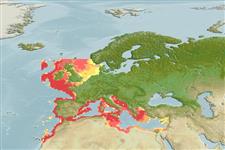Environment: milieu / climate zone / depth range / distribution range
Οικολογία
Θαλασσινό(ά) βενθικό(ς); εύρος βάθους 7 - 800 m (Ref. 6501). Temperate; 70°N - 26°N, 15°W - 36°E
Northeast Atlantic: British Isles south to Cape Bojador, West Sahara and the Mediterranean.
Length at first maturity / Μέγεθος / Βάρος / Age
Maturity: Lm ? range ? - ? cm
Max length : 40.0 cm SL αρσενικό/απροσδιόριστο; (Ref. 4703); common length : 20.0 cm TL αρσενικό/απροσδιόριστο; (Ref. 3397)
Ραχιαίες άκανθες (συνολικά) : 0; Μαλακές ραχιαίες ακτίνες (συνολικά) : 79 - 86; Μαλακές εδρικές ακτίνες: 65 - 69. Dorsal fin origin closer to tip of snout than to anterior edge of eye. Dorsal and anal fins terminate just a little on the blind side of the caudal peduncle. Lateral line forms a distinct curve above the pectoral fin.
Inhabits soft bottoms (Ref. 6501).
Distinct pairing during breeding (Ref. 205). A determinate spawner (Ref. 72169).
Nielsen, J.G., 1990. Scophthalmidae. p. 1026. In J.C. Quero, J.C. Hureau, C. Karrer, A. Post and L. Saldanha (eds.) Check-list of the fishes of the eastern tropical Atlantic (CLOFETA). JNICT, Lisbon; SEI, Paris; and UNESCO, Paris. Vol. 2. (Ref. 6501)
IUCN Red List Status (Ref. 130435)
Threat to humans
Harmless
Human uses
αλιεία: περιορισμένης εμπορικότητας
Εργαλεία
Special reports
Download XML
Διαδικτυακές πηγές
Estimates based on models
Preferred temperature (Ref.
123201): 7.5 - 15.1, mean 11.5 °C (based on 292 cells).
Phylogenetic diversity index (Ref.
82804): PD
50 = 0.7520 [Uniqueness, from 0.5 = low to 2.0 = high].
Bayesian length-weight: a=0.00468 (0.00381 - 0.00575), b=3.12 (3.06 - 3.18), in cm total length, based on LWR estimates for this species (Ref.
93245).
Τροφικό Επίπεδο (Ref.
69278): 3.7 ±0.3 se; based on diet studies.
Generation time: 5.6 (5.0 - 6.1) years. Estimated as median ln(3)/K based on 38
growth studies.
Ελαστικότητα (Ref.
120179): Μεσαίο(α), ελάχιστος χρόνος για διπλασιασμό πληθυσμού 1,4 - 4,4 έτη (K=0.14-0.26; tmax=13).
Prior r = 0.33, 95% CL = 0.22 - 0.49, Based on 4 full stock assessments.
Fishing Vulnerability (Ref.
59153): Moderate to high vulnerability (48 of 100).
Climate Vulnerability (Ref.
125649): Low to moderate vulnerability (30 of 100).
Nutrients (Ref.
124155): Calcium = 39.8 [20.1, 67.5] mg/100g; Iron = 0.311 [0.126, 0.628] mg/100g; Protein = 19.7 [17.8, 21.4] %; Omega3 = 0.676 [0.299, 1.641] g/100g; Selenium = 15.2 [5.7, 41.6] μg/100g; VitaminA = 14.5 [4.2, 47.1] μg/100g; Zinc = 0.417 [0.234, 0.828] mg/100g (wet weight); based on
nutrient studies.
